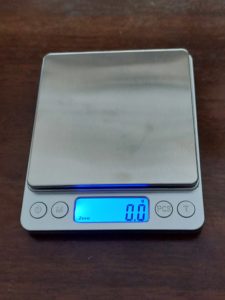Calibrating Your Scale
Calibrating your scale ensures that you’re getting accurate measurements. You may know how to use the Tare button to reset your scale. That’s a good start, but calibrating is a process that basically tells your scale how to measure certain weights. Scales often come calibrated when they’re new. However, like any other piece of measuring equipment, they can lose accuracy over time.
Here’s how to calibrate your scale:
What You Need to Calibrate Scales
Resetting your scale doesn’t calibrate it, although it can ensure that your scale isn’t reading measuring bowls or trays as part of its readings. Calibrating your scale requires a standard or device to measure against. For scales, this comes in the form of calibration weights.
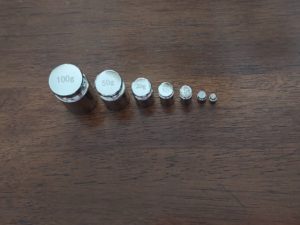 Calibration weights are weights that are verified to weigh a certain amount whether it’s a gram or hundreds or kilograms. Fortunately, these standard weights are really the only thing you need to calibrate your scale. You may choose to get a single calibration weight. However, if you need to weigh things in rather different amounts, it’s a good idea to get a set of calibration weights.
Calibration weights are weights that are verified to weigh a certain amount whether it’s a gram or hundreds or kilograms. Fortunately, these standard weights are really the only thing you need to calibrate your scale. You may choose to get a single calibration weight. However, if you need to weigh things in rather different amounts, it’s a good idea to get a set of calibration weights.
It’s best to use a calibration weight that’s close to the amount of weight you routinely measure. If you only measure very small amounts, you might use a 1 or 10 gram weight. However, if you tend to measure in higher quantities, a larger weight, such as 100 grams, or a kilogram may serve you better.
How often to calibrate your scale
How often to calibrate scales? That’s a question with many answers. Of course, it also depends on how often you use your scale, and the amounts you need to weigh. For intermittent to semi-regular use, you should plan on calibrating your scale every 6 to 12 months. However, if you’re using your scale more frequently, you may need to calibrate it at least once a month if not even more often.
The good news is that once you’re used to it, calibrating your scale takes very little time. There’s nothing wrong with double checking your scale more often to avoid errors.
How to Calibrate Your Scale – Step by Step
Note: the scale we use in the examples below uses automatic calibration, and can calibrate with standards from 3000g to 100g. To get this scale, you can order it on Amazon here.
As with any process, the first step is getting your supplies together. In this case, you really only need two things- your scale and your calibration weight (or weights) of choice.
Once you have these two key items, it’s time to get started. Decide which weight you want to use. Power your scale on.
Ideally, when you power your scale on, it should read “0.” If it doesn’t, follow the steps in this guide to reset your scale. Once it does read 0, you’re ready to get started.
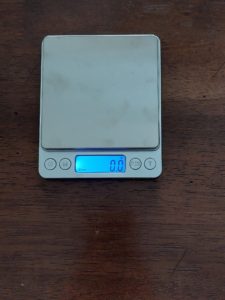 Put your scale in calibration mode. Scales may use different buttons to indicate the calibration setting. In this case, the scale uses a button with the letter ‘M.’ If you’re unsure what to press, check your user manual to be sure. Next, press the calibration button.
Put your scale in calibration mode. Scales may use different buttons to indicate the calibration setting. In this case, the scale uses a button with the letter ‘M.’ If you’re unsure what to press, check your user manual to be sure. Next, press the calibration button.
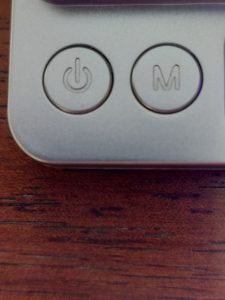 Set your calibration weight on the scale. The goal is to get the scale to read the same amount of weight as the calibration standard. If your scale is calibrated and accurate, the scale will show the exact weight you’ve put on it. If it doesn’t, you need to calibrate your scale, essentially showing it that this is the measurement to compare other things to.
Set your calibration weight on the scale. The goal is to get the scale to read the same amount of weight as the calibration standard. If your scale is calibrated and accurate, the scale will show the exact weight you’ve put on it. If it doesn’t, you need to calibrate your scale, essentially showing it that this is the measurement to compare other things to.
 Automatic vs. manual calibration
Automatic vs. manual calibration
There are two main types of calibration you’ll find in scales. First, there’s the automatic option. Automatic calibration means the scale comes with preset calibration weights.
The second option is manual calibration. This means there are no preset weights to calibrate by. With manual calibration, you enter the standard to calibrate by yourself.
There are advantages and disadvantages to each method, but which one you use typically depends on the type of scale you buy.
Automatic calibration is great if you have a set of standard weights to use, and don’t want to manually enter the weight of your standards. However, if you only have one or two calibration weights to choose from, the set weights for automatic calibration might not include the weights you already have.
Manual calibration allows you more choice when it comes to the weight of the standards you want to use. You don’t have to ensure that the standards you have fit within the preset weights the scale defines. However, you still need to make sure you’re using accurate standards to calibrate with, and you’ll have to make sure you’re careful when entering the weight you’re using.
With that said, both methods work equally well as long as you calibrate properly and use accurate standards.
Tips:
- If you don’t already own a calibration weight (or set of standards), but do own a scale, make sure the weights you order fit within the set range (if your scale uses automatic calibration).
- Don’t choose calibration standards simply because they’re the cheapest option. You should always look for a reputable product that you can trust is made with high accuracy.
- If you don’t have a scale or calibration weight yet, make sure that both are compatible with one another.
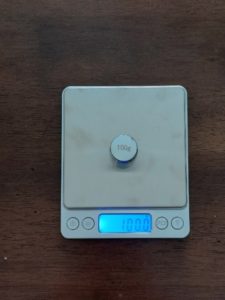 Automatic vs. manual calibration
Automatic vs. manual calibration